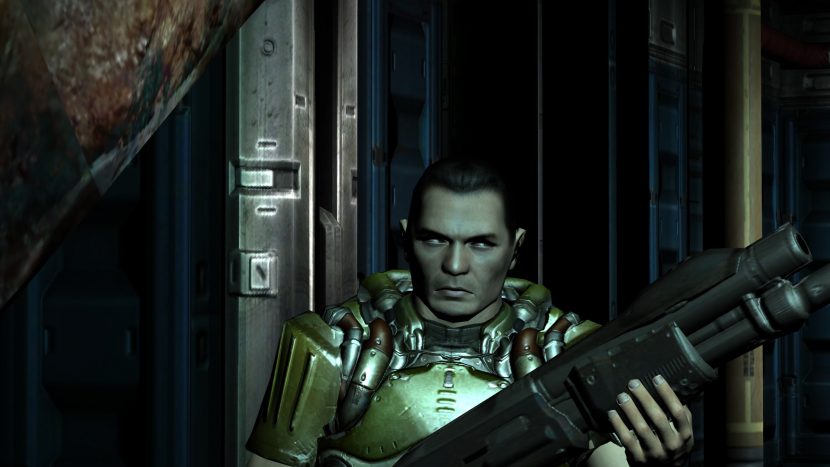It’s funny how both Resident Evil and Doom had major resurgences over the last decade after some misfires. I’ve already spoken a lot about RE, but for today, I want to talk about how id Software had their heart (and shotgun) in the right place with Doom 3 but made some rookie mistakes in its design and implementation.
No Ripping and Tearing:
The story of Doom 3 is much like the stories of all the other Dooms: demons from hell invade and we must stop them. Unlike the previous games where you play as the “Doom Guy”, this time, you are just a regular no named marine. The cutscenes in Doom 3 are on the generic side, especially compared to the “I don’t give a damn” style of Doom 2016 and the over-the-top nature of Doom Eternal.
Even though this is a game with “Doom” in the title, the developer intentions were not to make another FPS, but to try and slow things down for a more horror atmosphere.
My Kingdom for Some Duct Tape
The major design element of Doom 3 was to use lighting and darkness to keep the player on edge. Most of the base is underpowered, leading to many darken rooms and blind spots for enemies to attack. In the original version of the game, your only light source was a flashlight that had to be used in exchange for a weapon. The dynamic was that you would use the flashlight to light your way and spot enemies in the dark, and then switch to a weapon and fire hoping that you can hit them.
As with previous games, the enemies are possessed former humans and the invading demons. All the design changes in Doom 3 were made to make the player feel weak. The gunplay is perhaps the weakest out of the entire series, with Doom 3 featuring the worse shotgun I think I’ve seen in any FPS. Any attacks by enemies will cause the camera to jerk violently: messing with your ability to aim. Unlike FEAR, which was praised for its enemy AI, the Doom 3 enemies are on the dumb side. There were many cases where enemies would just run into a room one at a time and into my firing range.
Much has been talked about in terms of FPS design about the use of monster closets and derivative levels, and Doom 3 epitomizes that. The game absolutely loves to fill every possible wall with a closet, or teleport enemies in every few feet. Worse still, the game pulls the same trick of summoning an enemy directly behind the player so often that I always turn around when a fight starts. Every area outside of Hell as the same industrial quality to it, which also makes each area look the same. There is just no sense of personality to the levels or flow to how the player moves through them.
In the end, Doom 3 didn’t work as either a shooter or a horror game, and I feel has been the reason why more developers didn’t want to make a horror FPS.
A Misaligned Goal
The idea of making a survival horror FPS has merit, but Doom 3 was not the answer for it. The issue is that you have a team and franchise built around high-speed action FPS gameplay, and that’s not what you want out of survival horror. Instead of designing a game built around a slower pace, the developers did everything they could to hamstring the player to force them to take it slow, and that approach doesn’t work.
Series like Metro, STALKER, and even the early parts of Bioshock, understood that quality gameplay can be either fast or slow, but it still needs to feel good to play. Metro goes all-in on its themes and focus on survival and exploration; it doesn’t feel like another title. You can’t retrofit an arcade shooter and transform it into the next Resident Evil, what should have been done was a complete build from top-to-bottom. When the developers released the “BFG Edition” that put the flashlight on the player; all that did was reduce the tedium of playing Doom 3, but it didn’t make it better. Therefore Resident Evil 4 continues to hold up well because the developers went all-in on the redesign and used nothing from the previous games. Looking forward, we saw how id learned its lesson with Doom 2016 and committing to a singular design.
There is a lot of room to explore with the design of a FPS and survival horror, and we’ve seen that with the series I already mentioned. Give me a methodical shooter, with a slower pace, have the player face enemies who do more than just run at the player, and there’s potential there. Resident Evil 7‘s first-person perspective worked amazingly well and could be a solid foundation for horror.
Dueling Dooms
Doom 3 is a game lost in time: it’s not exciting enough as a Doom game, not compelling enough as a horror game, and has all the annoying tropes of modern FPS design. I can’t help but think that the failure of Doom 3 was one of the lynchpins for indie developers to eschew combat in their horror games. The lesson is that good game design is good game design, and when something feels out of place, it drags everything down with it. If you’re going to create a new design for a major franchise, then you need to start back at square one, because retrofitting often ends up with a game that just doesn’t feel right to play.
For more on horror design, Game Design Deep Dive Horror will be out sometime late 2021/early 2022, and my third book Game Design Deep Dive Roguelikes is now available for preorder.
If you enjoyed my post, consider joining the Game-Wisdom discord channel open to everyone.


